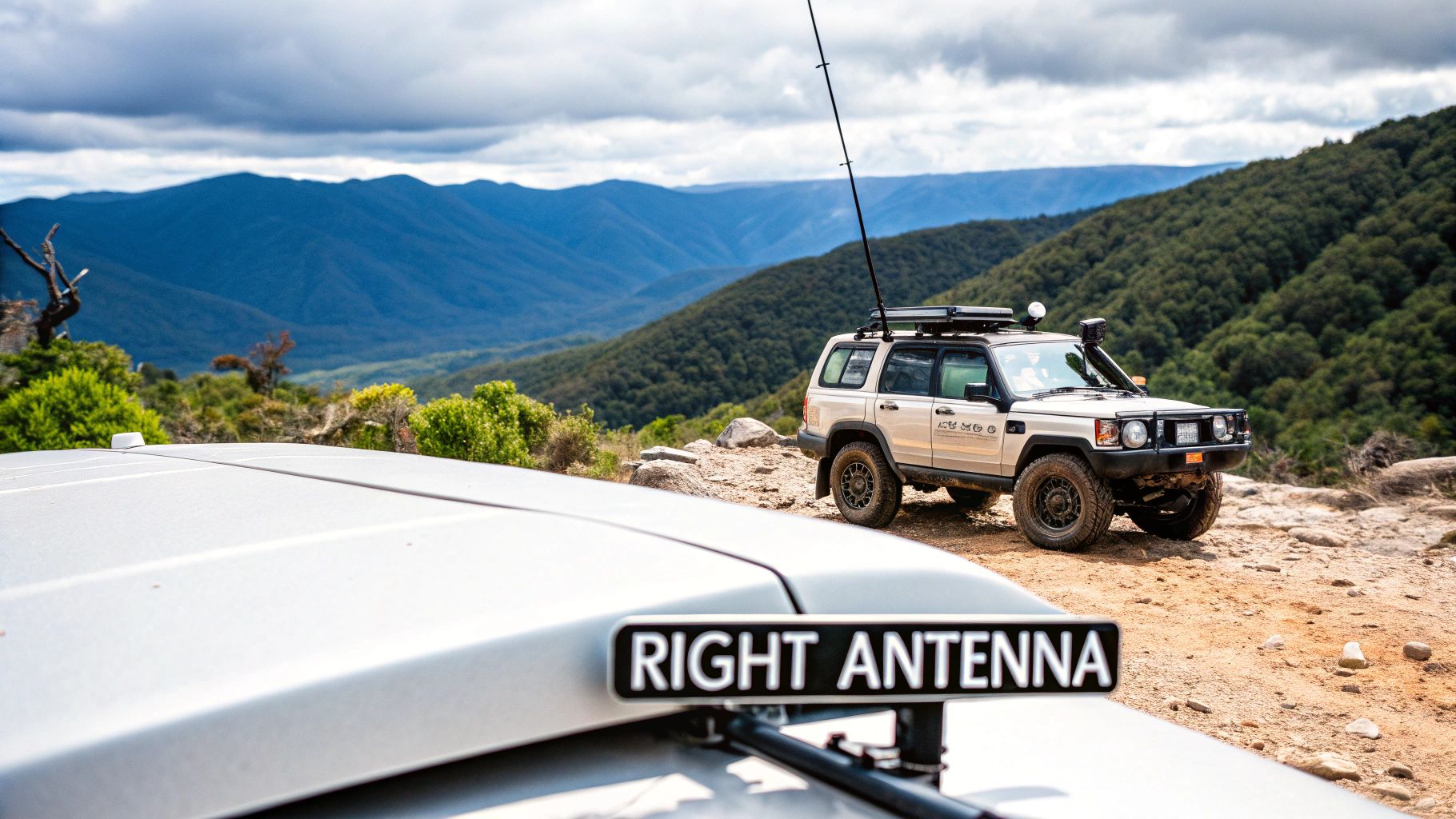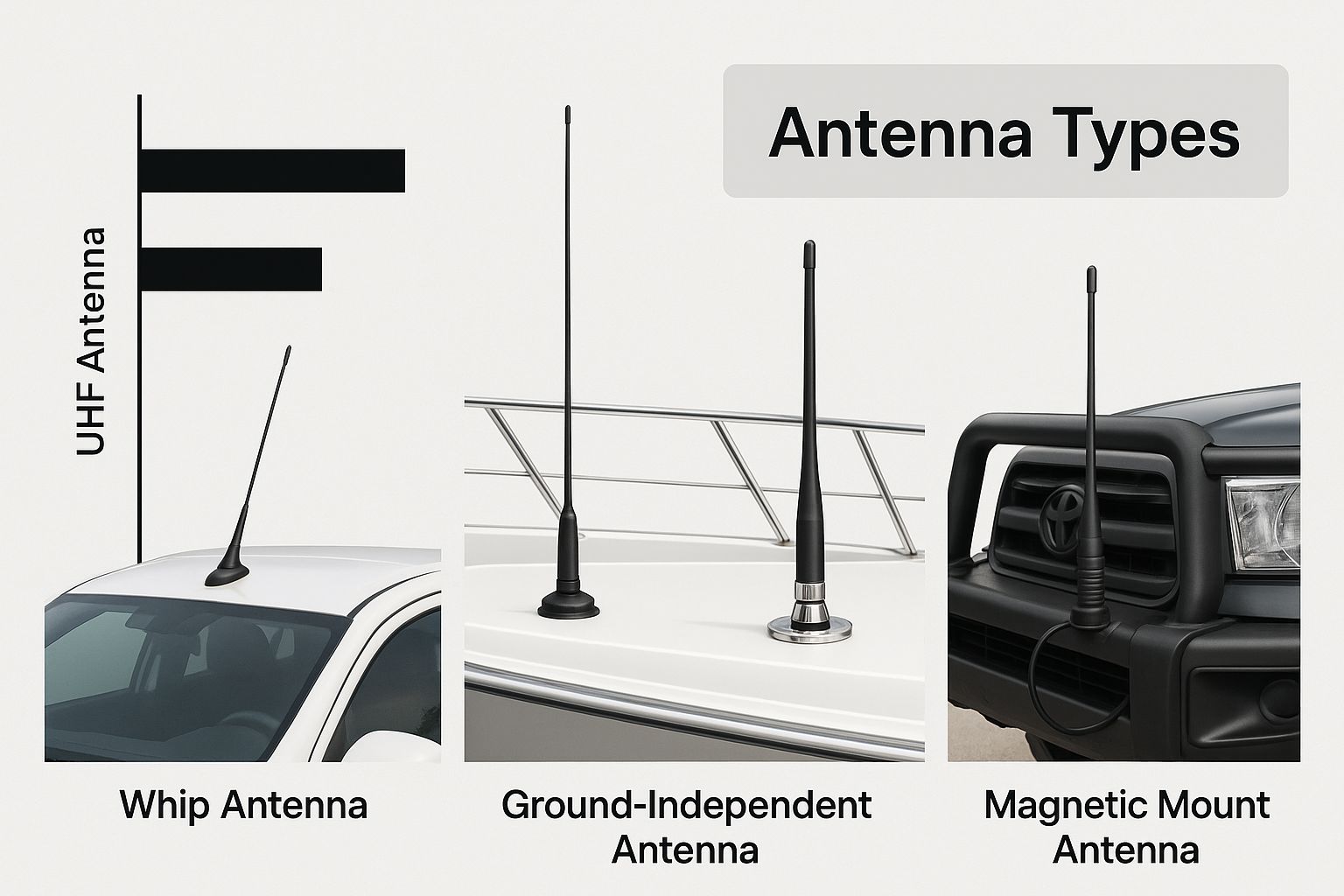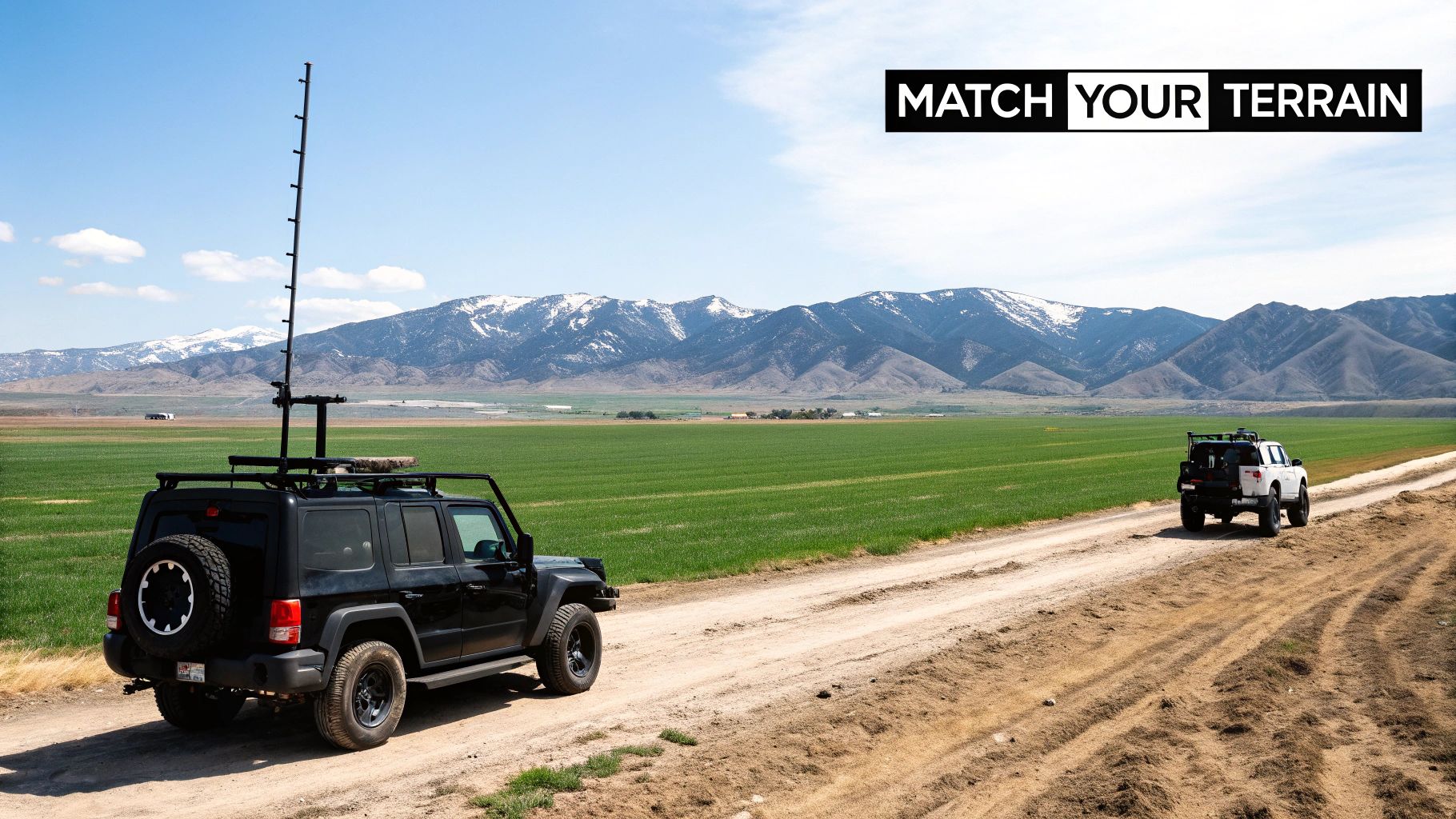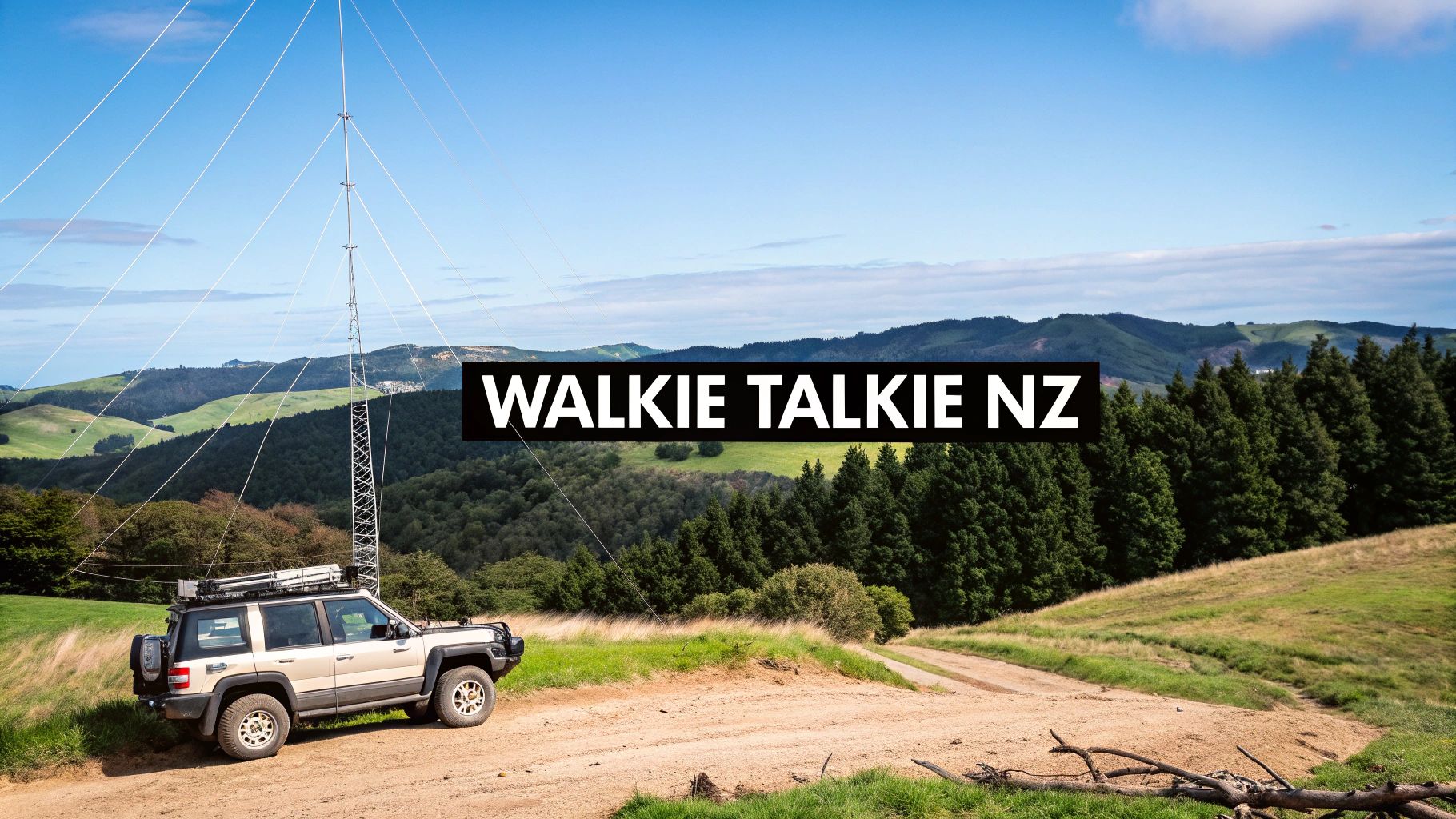Finding the Best UHF Antenna NZ for Your Needs
Picking the right UHF antenna for your needs here in NZ is probably the single most important decision you'll make for clear, reliable communication.
It’s not just another piece of kit; it's the very heart of your radio setup, the thing that ensures you stay connected when it counts.
Why Your Antenna Choice Is So Critical
Think about it.
Whether you're navigating remote 4WD tracks in the back country, coordinating a busy construction site, or looking after health and safety out on the water, your antenna's performance is what determines your signal's strength, clarity, and range.
A generic, off-the-shelf antenna just won't cut it in New Zealand's diverse and often challenging terrain.
This guide is designed to cut through the noise. We’ll get into the important stuff like antenna gain (dBi), physical length, and mounting options, but we'll translate all the technical jargon into practical advice you can actually use.
Matching the Hardware to Your World
The whole goal here is to pick an antenna that's a perfect match for what you're doing, so you get the best possible performance.
The difference between a high-gain whip antenna and a low-gain one can literally be the difference between crystal clear comms and dead silence.
- For Wide Open Country: A high-gain antenna is your best bet. It focuses the signal into a tight beam, pushing it across long, flat distances.
- For Hilly or Mountainous Terrain: You'll want a low-gain antenna. It sends the signal out in a much wider, more circular pattern, which is better for getting over and around hills and other obstacles.
- For Marine Use: A ground-independent antenna is non-negotiable for fibreglass boats, which don't have the metal 'ground plane' a standard antenna needs to work properly.
Mobile Systems Limited are experts at matching the right antenna to the job. We understand the unique communication challenges that New Zealand’s geography throws at us and help you build a solution that genuinely works for your purposes.

Understanding the Common Trade-Offs
Let's be realistic—choosing and mounting your antenna always involves a few trade-offs.
For instance, the centre of a vehicle roof gives you the BEST all-around signal pattern, but that might not be practical for a work ute loaded with roof racks and gear.
Likewise, a super long, high-gain antenna will give you incredible range on the open road, but it can quickly become a liability in dense bush or low-clearance city car parks.
Weighing these factors—performance, practicality, and durability—is the key to getting it right.
Once you understand how these elements apply to your specific situation, you can invest in a communication system that won’t let you down. It's about moving beyond just buying a product and instead building a solution that’s right for you.
Getting to Grips with UHF Frequencies in New Zealand
To really nail your antenna setup, it pays to understand the world it lives in: the Ultra High Frequency (UHF) radio spectrum.
Think of it as a massive, invisible highway managed by New Zealand's Radio Spectrum Management (RSM).
This isn't just empty airwaves. This highway carries the signals for everything from your Freeview TV and commercial two-way radio networks to mission-critical communications for our emergency services and even the cellular networks your phone relies on.
It’s a bustling and vital piece of our national infrastructure.
How UHF Signals Get Around
UHF signals are known for their shorter wavelength, which gives them a massive advantage for what's called line-of-sight communication.
Picture pointing a torch in the dark—the beam travels in a dead straight line. UHF signals work in a similar way. This makes them incredibly effective in built-up city environments, where the signals can bounce off buildings, and just as good out in the open country with nothing in the way.
That direct path is exactly why a quality antenna is so critical for grabbing these signals cleanly.
Of course, this line-of-sight behaviour means that big obstacles like hills or large buildings can block the signal completely. But here's the trade-off: that same short wavelength helps UHF signals punch through walls and other smaller obstacles much better than lower-frequency signals like VHF.
This unique trait makes UHF the go-to choice for everything from a handheld walkie talkie on a building site to a powerful vehicle-mounted radio on the farm.
If you're keen to dive deeper into how these frequencies are managed, have a look at our guide on UHF radio in NZ.
The Heart of Licence-Free Comms
One of the most common uses for the UHF band here in New Zealand is the UHF CB (Citizen Band) service. For countless businesses and weekend adventurers, this is the backbone of licence-free radio communication.
In NZ, UHF CB radio users get access to 77 channels without needing to apply for a specific licence. Out of these, 32 channels are specifically reserved for repeater stations, which are absolutely essential for boosting your signal and getting coverage across our hilly terrain. This network got a major upgrade back on May 27, 2011, when the number of channels was bumped up from the original 40.
All this technical stuff really brings home just how important your choice of UHF antenna is. Picking the right one and installing it properly is your ticket to cutting through the noise, pushing your signal as far as it can go, and making sure you're heard loud and clear every time.
Exploring Different Types of UHF Antennas
Picking the right UHF antenna NZ is definitely not a one-size-fits-all job.
The market here in New Zealand is packed with specialised designs, and each one is built for a specific purpose and environment. Getting your head around the main types is the first step to building a communication setup that actually works when you need it to.
For most vehicles, the classic whip antenna is still the king. It's loved for its flexibility and sheer rugged durability, making it the go-to for farm gear and 4WD trucks that take a beating from rough tracks and constant vibration.
These antennas are designed to simply bend out of the way when they smack into an overhanging branch, then spring right back.
Ground-Plane and Ground-Independent Antennas
Now, here’s a CRITICAL point you need to understand: the difference between ground-plane dependent and ground-independent antennas.
Most traditional whip antennas need a decent-sized metal surface, like the roof of your ute, to act as a "ground plane." This metal surface essentially becomes part of the antenna system itself, helping to push the signal out properly.
If you want to dive deeper into the science behind this, we’ve got a great article on how antennas work.
But what happens when you need to mount an antenna on a fibreglass boat, a modern truck with a composite cab, or even the bullbar on your vehicle? These surfaces just don't offer the metal ground plane needed for a standard antenna to work correctly.
This is exactly where ground-independent antennas come in. They are cleverly designed with their own ground plane built right into the base. This lets them perform perfectly without relying on the surface they're mounted to, making them the ONLY real choice for marine use or on vehicles with non-metallic bodies.
This infographic gives you a quick look at three common UHF antenna types and where you'd typically mount them.

As you can see, matching the antenna design to the mounting spot and what you’re using it for is hugely important.
Specialised Antennas for Every Need
Beyond what you'd stick on a vehicle, there are other specialised antennas designed for different jobs.
- Fixed Base Station Antennas: These are the big guns. They're larger, high-performance antennas made for permanent installation on a building to serve as a central comms hub for a farm or worksite.
- Magnetic Mount Antennas: Need a temporary solution? These are perfect. They have a powerful magnetic base that clamps onto any steel surface, giving you a quick setup without drilling any holes.
Top-tier manufacturers like RFI, Pacific Aerials, and GME have absolutely nailed these designs for New Zealand’s unique and often harsh conditions.
Their gear features better construction, solid weatherproofing, and performance tuning that you just don't get from generic alternatives. Choosing the right type from a trusted brand is the best way to make sure your system runs at its best.
At Mobile Systems, we're experts in matching people with the right antenna for the job. We live and breathe the specific demands of NZ's varied terrain and industries, so we can make sure you get the right hardware for maximum reliability and performance.
Matching Your Antenna to Your Environment

You can have a top-of-the-line radio from a brand like Tait or Motorola, but it's only as good as the antenna it's paired with.
This is where we connect the dots, moving from theory to the real-world trade-offs you’ll face when choosing and mounting your UHF antenna NZ.
The single biggest decision comes down to antenna gain, measured in dBi (decibels relative to an isotropic radiator).
A great way to think about it is like adjusting the beam on a powerful torch. A high-gain antenna focuses all its energy into a long, narrow beam, while a low-gain antenna spreads the light out into a wider, more spherical shape.
Gain Versus Terrain: The Critical Trade-Off
Picking the right gain is absolutely CRUCIAL for clear communication across New Zealand's famously varied landscapes. There's no single "best" gain; the right choice is always the one that matches the environment you operate in most.
-
High-Gain Antennas (e.g., 6.6 dBi and above): These are your long-range specialists. Their focused, flat signal pattern is perfect for the wide-open Canterbury Plains, the Desert Road, or long, straight coastal routes. The catch? That narrow beam can easily overshoot its target or get completely blocked in hilly country.
-
Low-Gain Antennas (e.g., 2.1 dBi to 4.5 dBi): These antennas are the undisputed champions of complex terrain. Their wide, almost balloon-like signal pattern radiates energy both upwards and downwards, making it far more effective at navigating the rolling hills of the Waikato or the steep, rugged valleys of the West Coast.
-
Medium-Gain Antennas (around 4.5 to 6.6 dBi): Often seen as the ideal all-rounder, these strike a good balance between range and broad coverage. They're a solid choice for anyone who regularly travels through a mix of flat and hilly areas.
If you'd like a more detailed breakdown of how this works, we've got a full guide where we've got the specifics of antenna gain explained.
To make this even clearer, here's how different gain levels stack up against typical Kiwi environments.
Antenna Gain Trade-Offs for New Zealand Terrain
| Antenna Gain (dBi) | Best Suited For | Signal Radiation Pattern | Common Use Case |
|---|---|---|---|
| Low (2.1 - 4.5) | Hilly, mountainous, or dense urban areas | Wide, almost spherical | Forestry, farming in rolling country, 4WDing on tough tracks |
| Medium (4.5 - 6.6) | Mixed terrain; a combination of open roads and rolling hills | A balanced, flattened oval shape | Sales reps, couriers, or anyone travelling between regions |
| High (6.6+) | Flat, open country with clear line-of-sight | Very narrow and flat, focused like a laser beam | Long-haul trucking, agricultural work on the plains |
As you can see, the "best" antenna is all about matching its signal shape to the landscape you're in.
The Importance of Mounting Location
Where you physically place the antenna on your vehicle has a massive impact on its performance, creating what's known as its radiation pattern. The textbook-perfect spot is smack-bang in the centre of a large metal roof, as this gives the antenna a uniform ground plane to radiate from in all directions.
Expert Insight: An improperly mounted antenna can create huge signal "shadows" around your vehicle, drastically cutting your communication range in certain directions. Taking the time to pick the best possible mounting point is every bit as important as choosing the right antenna in the first place.
Of course, that perfect roof-centre mount isn't always practical, especially with roof racks, light bars, or other gear in the way. This means you often have to weigh the pros and cons of other locations.
Here are some common mounting spots and the compromises that come with them:
- Bullbar: Easy to install and keeps the antenna forward. The big downside is that the signal is heavily blocked to the rear by the vehicle's cab.
- Guard Mount: A common and practical compromise. However, it creates a directional pattern, favouring the side of the vehicle opposite the antenna.
- Boot/Hatch: A discreet and easy option for smaller antennas. Similar to a guard mount, it creates a significant signal shadow on the other side of the vehicle.
Ultimately, selecting and mounting a UHF antenna is all about finding the right balance between peak performance, practicality, and how you want it to look. The team here at Mobile Systems are experts at assessing your specific needs—from your vehicle type to your typical travel routes—to recommend the best possible setup for clear, reliable communication.
Leading Antenna Brands Available in New Zealand
When your communication is critical—whether for running your business or for personal safety—the brand behind your antenna really does matter.
Here in New Zealand, a handful of manufacturers have built a solid reputation for producing rugged, reliable, and high-performance UHF antennas specifically designed for our often-challenging conditions.
Think of choosing a trusted brand as an investment in durability and dependable performance. Instead of getting lost trying to find help with a limited selection, focusing on specialist manufacturers means you're getting a product backed by years of research, development, and hard-earned, real-world testing.
The Specialist Manufacturers You Can Trust
In the world of professional communication, certain names just keep coming up, known for their exceptional build quality and precision engineering.
These are the brands that deliver the kind of reliability needed for everything from commercial vehicle fleets to remote farming operations.
Here are the key players you'll find in the New Zealand market:
- RFI: An absolute industry leader, famous for its incredibly robust engineering. RFI makes a huge range of antennas, covering both UHF and cellular solutions, and they are legendary for their durability in the harshest environments.
- Pacific Aerials: A proud New Zealand company that truly excels in creating world-class marine antennas. Their products are built from the ground up to survive the corrosive saltwater environment, making them a top choice for any boat and boating setup.
- GME and Uniden: Both are highly respected brands that offer the whole communication package, from the radio itself right through to the antenna. They have a variety of reliable antennas perfect for everything from recreational 4WD use to professional applications.
When you choose a product from one of these specialist brands, you're not just buying an antenna; you're buying peace of mind. Their focus on superior materials and meticulous manufacturing results in a product that performs consistently, year after year.
Why Brand Quality Is Non-Negotiable
A well-made antenna from a reputable manufacturer gives you distinct advantages over the generic, mass-produced alternatives.
The difference is in the details—things like better quality cable connector components, superior weather sealing to keep moisture out, and more precise tuning for optimal performance right across the UHF band.
This commitment to quality ensures your entire radio network operates at its best. It reduces the risk of frustrating signal loss, prevents potential damage to your radio from a poorly tuned antenna, and gives you the clear, consistent connection you rely on.
At Mobile Systems Limited, we're experts in supplying and recommending the best antenna for what you actually need to do. We work exclusively with these leading brands because we know their products are built to last and deliver the performance our clients demand.
By matching your needs with the right product from a trusted manufacturer like RFI or Pacific Aerials, we make sure your communication system is effective, reliable, and future proof.
Why Expert Guidance Makes All the Difference
Let's be honest, trying to get your head around the technical side of UHF antenna systems, radio frequencies, and all the hardware that goes with them can be a real headache.
It’s a complex world, and a small mistake in choosing a component can lead to poor performance, endless frustration, or even compromise your safety when you need your gear to work the most.
This is exactly where getting the right advice is so important.
Here at Mobile Systems, we aren’t just another supplier. We're system designers and genuine problem-solvers. Our team has hands-on, practical knowledge of all the leading professional brands like Tait, Motorola, and Hytera, plus we know the intricate antenna systems that make them sing.
A Communication Solution That Actually Fits
We take the time to listen and understand exactly what you need.
It doesn't matter if you're running a massive agricultural operation, managing a commercial vehicle fleet, or you're a weekend adventurer heading into the backcountry—we provide recommendations that are built for you.
Our goal is to make sure your solution is effective, efficient, and totally reliable from the moment you switch it on.
We don't just sell you a box. We deliver a complete communication solution designed for your specific environment and built to perform flawlessly when it counts. Getting it right the first time saves you time, money, and a whole lot of stress down the track.
Your Top UHF Antenna Questions Answered
When it comes to UHF antennas, a few questions pop up time and time again. We've been asked just about everything over the years, so let's clear up some of the most common queries we hear from Kiwis.
How Long Does My UHF Antenna Need to Be?
This is probably the number one question we get, and the answer isn't about physical length—it's about gain, measured in dBi. Think of it this way: a longer antenna generally means higher gain, which is fantastic for broadcasting over flat, open country like the Canterbury Plains.
But in New Zealand's famously varied terrain, a high-gain antenna can be a disadvantage. Shorter, lower-gain antennas are actually far better at handling hills, valleys, and built-up areas.
For most people driving across a mix of Kiwi landscapes, a medium-gain antenna (somewhere between 4.5 to 6.6 dBi) is the sweet spot. It offers the best all-round performance, giving you a versatile setup that works almost anywhere. The real trick is matching the gain to your typical environment, not just buying the longest aerial you can find.
What’s the Difference Between UHF and VHF Antennas?
They might look similar, but UHF (Ultra High Frequency) and VHF (Very High Frequency) antennas are designed for completely different radio frequencies. You absolutely CANNOT swap them.
In New Zealand, the distinction is pretty clear: VHF is the standard for marine radio. Its longer wavelength is much better at travelling over open water.
UHF, on the other hand, is the go-to for land-based communications. This includes your typical CB radio and the majority of commercial two-way radio networks used by businesses across the country. Because it operates on a higher frequency, a UHF antenna will always be physically shorter than a VHF one built for a similar job.
Will Any UHF Antenna Work with My Radio?
Not quite. While most UHF CB antennas are built for the right frequency (477MHz), two things are absolutely critical for performance and safety: the connector and the tuning.
First, check the simple stuff. The antenna's cable connector needs to physically match the socket on the back of your radio. Easy.
But the most important part is getting the antenna properly installed and tuned for a low SWR (Standing Wave Ratio). This isn't just a "nice-to-have"; it's a CRUCIAL step that prevents damage to your radio and ensures you're getting the best possible signal. An expert installer can verify this for you in minutes.
If you want to make sure you get the right advice for choosing and installing the perfect uhf antenna nz for your vehicle or business, it pays to trust the specialists. Contact Mobile Systems Limited today, and we'll help you build a communication solution that just works.
Find Your Perfect Communication Solution at mobilesystems.nz

